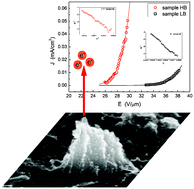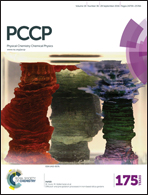Nanoshaping field emitters from glassy carbon sheets: a new functionality induced by H-plasma etching†
Abstract
This paper reports on the morphological and electrical characterization at the nanometer scale and the investigation of the field emission characteristics of glassy carbon (GC) plates which underwent H-induced physical/chemical processes occurring in a dual-mode MW-RF plasma reactor. Plasma treatment produced on the GC surface arrays of vertically aligned conically shaped nanostructures, with density and height depending on the plasma characteristics. Two kinds of samples obtained under two different bias regimes have been deeply analyzed using an AFM apparatus equipped with tools for electric forces and surface potential measurements. The features of electron emission via the Field Emission (FE) mechanism have been correlated with the morphology and the structure at the nanoscale of the treated glassy carbon samples. The measured current density and the characteristics of the emission, which follow the Fowler–Nordheim law, indicate that the plasma-based methodology utilized for the engineering of the GC surfaces is able to turn conventional GC plates into efficient emission devices. The outstanding properties of GC suggest the use of such nanostructured materials for the assembling of cold cathodes to be used in a harsh environment and under extreme P/T conditions.



 Please wait while we load your content...
Please wait while we load your content...